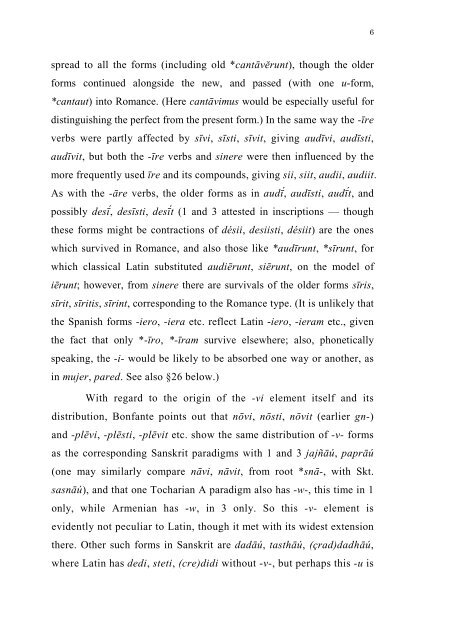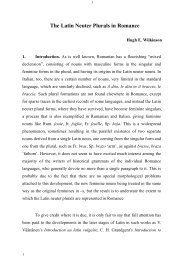THE STRONG PERFECTS IN THE ROMANCE ... - Page ON
THE STRONG PERFECTS IN THE ROMANCE ... - Page ON
THE STRONG PERFECTS IN THE ROMANCE ... - Page ON
You also want an ePaper? Increase the reach of your titles
YUMPU automatically turns print PDFs into web optimized ePapers that Google loves.
spread to all the forms (including old *cantāvĕrunt), though the older<br />
forms continued alongside the new, and passed (with one u-form,<br />
*cantaut) into Romance. (Here cantāvimus would be especially useful for<br />
distinguishing the perfect from the present form.) In the same way the -īre<br />
verbs were partly affected by sīvi, sīsti, sīvit, giving audīvi, audīsti,<br />
audīvit, but both the -īre verbs and sinere were then influenced by the<br />
more frequently used īre and its compounds, giving sii, siit, audii, audiit.<br />
As with the -āre verbs, the older forms as in audī, audīsti, audīt, and<br />
possibly desī, desīsti, desīt (1 and 3 attested in inscriptions — though<br />
these forms might be contractions of désii, desiisti, désiit) are the ones<br />
which survived in Romance, and also those like *audīrunt, *sīrunt, for<br />
which classical Latin substituted audiērunt, siērunt, on the model of<br />
iērunt; however, from sinere there are survivals of the older forms sīris,<br />
sīrit, sīritis, sīrint, corresponding to the Romance type. (It is unlikely that<br />
the Spanish forms -iero, -iera etc. reflect Latin -iero, -ieram etc., given<br />
the fact that only *-īro, *-īram survive elsewhere; also, phonetically<br />
speaking, the -i- would be likely to be absorbed one way or another, as<br />
in mujer, pared. See also §26 below.)<br />
With regard to the origin of the -vi element itself and its<br />
distribution, Bonfante points out that nōvi, nōsti, nōvit (earlier gn-)<br />
and -plēvi, -plēsti, -plēvit etc. show the same distribution of -v- forms<br />
as the corresponding Sanskrit paradigms with 1 and 3 jajñāú, paprāú<br />
(one may similarly compare nāvi, nāvit, from root *snā-, with Skt.<br />
sasnāú), and that one Tocharian A paradigm also has -w-, this time in 1<br />
only, while Armenian has -w, in 3 only. So this -v- element is<br />
evidently not peculiar to Latin, though it met with its widest extension<br />
there. Other such forms in Sanskrit are dadāú, tasthāú, (çrad)dadhāú,<br />
where Latin has dedi, steti, (cre)didi without -v-, but perhaps this -u is<br />
6









